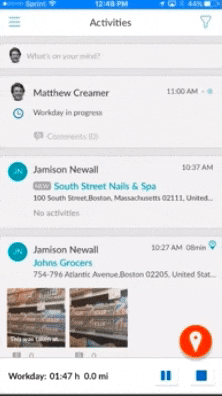You may know the importance of sales activity management, but which activities are the most direct drivers of success? How do you steer these high value activities in the right direction and best optimize your team’s strategy towards revenue?
The following activities are some of the most important things that your reps will do in the field, and it’s crucial that you have an active hand in them to make sure they’re being done right. In this post, we’ll look at three key drivers of sales that every manager should start monitoring if they want to reach higher levels of success.
Visit Frequency
While visits to existing accounts provide a huge value to brands, making just the right amount of visits will provide an even bigger value. It’s up to you to find that sweet spot between not enough visits and too many. Not enough, and you’re missing out on a chance to boost brand awareness and eventual sales. Too many, and you’re wasting more time and resources than the added return you’re getting.
How to Optimize Visit Frequency in the Field
Look at the data in each of your retail locations to comparatively see sales performance, and how that correlates with the number of visits you’ve done at each one. See how many visits you make to your top performing accounts versus accounts that are struggling. Adding extra visits could boost numbers that are dragging, while getting rid of unnecessary visits will increase the efficiency of your team. Use this data to find and assign the exact right number of visits for each account.

Audits
When performing a retail audit, there’s a lot of information that your reps could record, and organizing and communicating this information effectively is key. It’s important to take on a more active hand in audits so that you and your reps can be on the same page about what they’re seeing in the store. This is crucial if your team is going to collaboratively fix any compliance issues. Overall, having an involved role in retail audits will help to better ensure that your strategy is being carried out correctly at the store level.
How to Optimize Retail Audits
Help your reps to perform a more organized and data- oriented retail audit. Specify beforehand the exact metrics you want them to track during the visit. Typically, these include things like:
- Stock levels
- Descriptions of in-store displays and promotional materials
- Competitor activity
- Pricing
- In-store location of products
- Product damage
/Miscellaneous_Images/Screen%20Shot%202018-08-06%20at%2010.42.02%20AM.png?width=495&name=Screen%20Shot%202018-08-06%20at%2010.42.02%20AM.png)
Have a predetermined set of trackable metrics for your reps to look for before they even enter the store. In addition, create a streamlined and consistent format for reporting and relaying these metrics. This will help your reps to be more direct and focused with their approach as soon as they enter the store.
For a complete list of metrics you should be tracking in your retail audits, check out our retail audits checklist here!
New Business Development
Going out into the field to find new customers and partners is a huge part of any sales rep’s job, but it’s also extremely time consuming. In addition, the harsh truth is that a large portion of these visits will not be successful, but this doesn’t mean that they can’t be helpful! There’s a big difference between a low success rate and inefficiency, and by managing and monitoring these visits you can help your team to fine tune your strategy to be more effective.
How to Optimize New Business Development
Capturing data during the prospecting process helps reps better target their efforts and improve their success rates. Collect data from each contact to become smarter and more agile about your business development. Record things such as what made a certain prospect good or bad for your brand, or what prevented them from purchasing your product. Use this data to construct a more accurate customer persona, and iterate your outreach strategy as needed.
Consider using a mobile form like this one to record this data.
/Miscellaneous_Images/IMG_4062.png?width=250&name=IMG_4062.png)
Get Started Today
There are many sales activities that you can manage in order to optimize your team’s daily routine, but start with these three high value activities to begin guiding your team to more success. It’s important to establish that optimized chain of repeatable activities that lead to closed sales, and the best way to do that is by controlling what you can control, your team’s everyday activities.



/Miscellaneous_Images/Screen%20Shot%202018-08-06%20at%2010.42.02%20AM.png?width=495&name=Screen%20Shot%202018-08-06%20at%2010.42.02%20AM.png)
/Miscellaneous_Images/IMG_4062.png?width=250&name=IMG_4062.png)


